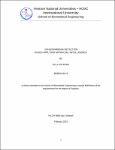| dc.description.abstract | Schizophrenia, bipolar disorder, and depression are psychiatric illness that causes negative effects
on individuals as well as society. Due to the significant overlap in the clinical symptoms of
depression (DD), bipolar disorder (BD), and schizophrenia (SZ), using conventional guidelines is
hard to discriminate between them. A proper differentiation between depression, bipolar disorder,
and schizophrenia patients is critical to lessen their effects. Therefore, an artificial intelligence
approach based on electroencephalography (EEG) data is suggested as an automated clinical
system to assist psychiatrists in the diagnosis of mental conditions. This system consists of three
stages. Firstly, the data is up-sampled by SMOTE to produce balanced data. Then, feature
extraction and selection are used to reduce the number of irrelevant features. The final stage is a
classification complied with machine learning and deep learning. The recommended models
include K-Nearest Neighbor, Logistic Regression, Gradient Boosting, Random Forest, Neural
network, VGG19, and Efficient Net B0.
The proposed method achieves the highest accuracy of 97.50%, in a data from 199 people with
major depressive disorder, 117 participants with schizophrenia, and 67 subjects with bipolar
depression. The proposed methodology has the potential to be a valuable supplemental tool for
medical professionals with future improvement. | en_US |


